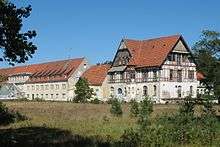Hohenlychen Sanatorium

The Hohenlychen Sanatorium was a complex of sanatoriums in Lychen, Uckermark district (a bit north of Berlin), Germany, that existed from 1902 to 1945. While the complex was originally built in 1902 to house tubercular children, by the 1930s the Hohenlychen Sanitorium had become one of the main medical facilities of the Schutzstaffel, where injured or convalescing SS-men were treated.
Many preeminent SS doctors trained or were stationed at Hohenlychen, the most infamous being SS-Sturmbannführer Doktor Karl Gebhart, who was sentenced to death for war crimes. In 1935, Gebhardt was appointed Medical Superintendent of Hohenlychen Sanatorium, which he changed from a sanatorium for tuberculosis patients into an orthopedic clinic. At Hohenlychen Sanatorium, Gebhardt started the first sports medicine clinic in Germany and developed sports programs for amputees and other disabled people. Gebhardt was also appointed to the Deutsche Hochschule für Leibesübungen (German College for Physical Education) in 1935, where he became the first professor of sports medicine in Berlin. Hohenlychen Sanatorium became the sports sanatorium for the Third Reich and served as the central hospital for the athletes who participated in the 1936 Summer Olympics.
In the final days of the Third Reich, April 1945, Reichführer-SS Heinrich Himmler left Berlin for Hohenlychen. After visiting Hitler in the führerbunker to congratulate him on his birthday, he made a last attempt to persuade Hitler to leave Berlin. Even though he tried to use the influence of Walther Hewel, a favourite diplomat of Hitler, they did not succeed in their attempt to do so. Himmler left Berlin the same day, inviting Reichminister Albert Speer to visit him at his retreat in Hohenlychen.
In literature
In the Prix Goncourt winning novel, Les Bienveillantes, the Hohenlychen Sanatorium was the location of the protagonist Maximilian Aue's hospitalisation after having been shot in the head at Stalingrad.
Sources
Hans Waltrich. Aufstieg und Niedergang der Heilanstalten Hohenlychen (1902 bis 1945). Strelitzia, Blankensee Press, 2001.
External links
| Wikimedia Commons has media related to Heilstätten Hohenlychen. |
Coordinates: 53°12′05″N 13°19′34″E / 53.2014°N 13.3261°E